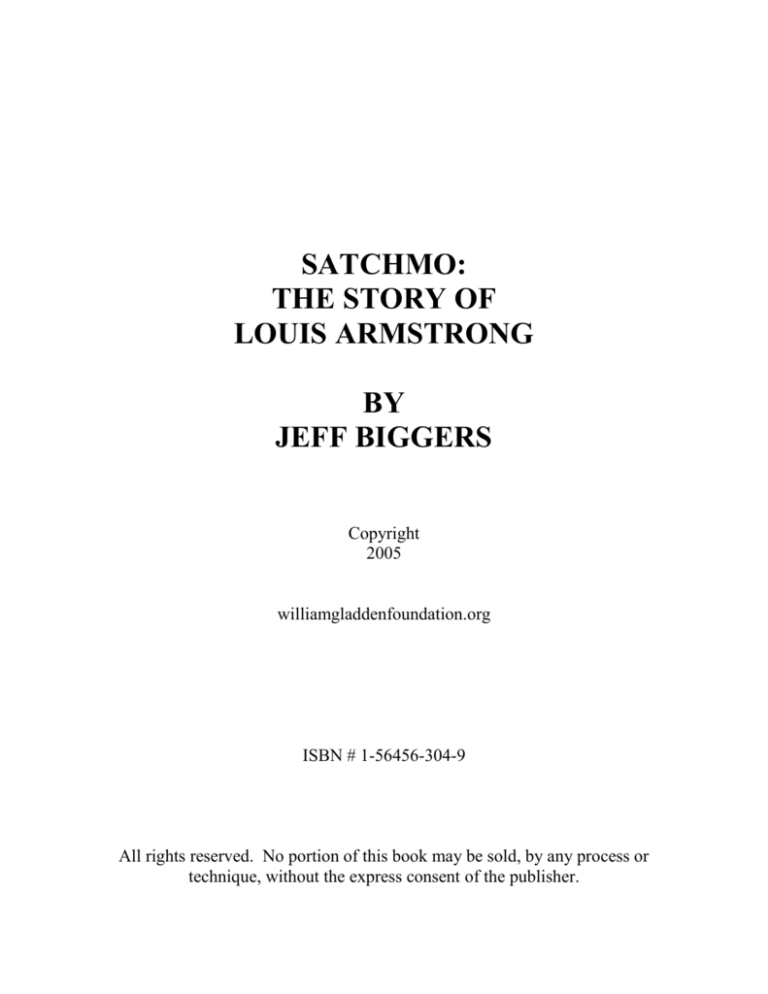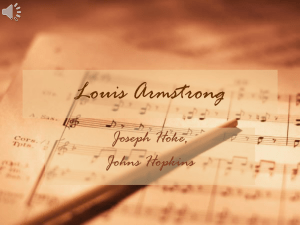
SATCHMO:
THE STORY OF
LOUIS ARMSTRONG
BY
JEFF BIGGERS
Copyright
2005
williamgladdenfoundation.org
ISBN # 1-56456-304-9
All rights reserved. No portion of this book may be sold, by any process or
technique, without the express consent of the publisher.
TABLE OF CONTENTS
CHAPTER ONE: Coming Home……….…………………………………….……….….3
CHAPTER TWO: Back O’Town……………………………………………….…….….5
CHAPTER THREE: The Colored Waifs’ Home For Boys………..…………………..…7
CHAPTER FOUR: Jazz…………………………………..……………………………..10
CHAPTER FIVE: The Jazz Age.…………………………………..…………………….11
CHAPTER SIX: Swing………………………..…………………………………...……12
CHAPTER SEVEN: The Ambassador of Jazz….……………………………………….13
VOCABULARY…………………………………………………………………………15
REVIEW QUESTIONS:…………………………………………………………………16
-II-
CHAPTER ONE:
COMING HOME
The train station was packed with people. Standing on the edge of the platforms, men
and women shouted and waved. Some clapped their hands to the music. The air was full
of excitement. Eight marching bands practiced to the side.
The people of New Orleans were waiting for a great moment. It was 1932. Louis
Armstrong, the famous jazz musician, was coming home.
Then, several boys cried out, pointing their fingers at the train tracks. “He’s coming!
He’s coming!” All heads turned. Pouring great puffs of smoke from its engine, the train
raced around the bend with a roar. The crowd did not even move back. As the train
squealed to a stop, the tune of the bands rose with a rousing tempo.
With a wide smile full of surprise, Louis Armstrong stepped from the train. The greeting
pleased him. He could hear people calling out their welcome. After years of playing in
cities all over the world, the legendary African-American jazz trumpeter and singer had
come home. Louis Armstrong was one of America’s favorite musicians.
A great parade began. Louis rode in a car with the top down. Along the streets, fans
screamed and tried to shake his hand. Louis did not mind. He wanted to see all the new
sights of his old city. So many memories came to his mind.
The car suddenly came to a halt. A man stepped to the side. He had the eyes of a proud
father. Pointing behind him, unable to say a word, the man directed Louis’ gaze to a
band of young boys standing straight in their uniforms. Two boys held a banner with the
words, “Waifs’ Home Colored Band” written across it.
“You are their hero, Louis,” the man said. His name was Mr. Peter Davis. He looked
back at the boys in the band, adding to Louis, “Would you visit with us while you are
here?”
Louis laughed, and then he waved to the band members. Frozen with their instruments in
their hands, some of the boys looked like they were too scared to play a note.
“Of course I will,” Louis shouted.
Louis Armstrong never forgot his first band.
Keeping his promise, Louis visited the Colored Waif’s Home for boys the next day. The
waif’s home was a detention center for young boys who had been in trouble with the law.
This was not the first time for Louis to visit the home. He had lived there years before,
when he was a young boy.
-3-
The band had prepared a show for Louis. The great musician listened and clapped,
impressed by the young band members. Mr. Davis spoke to Louis. He was the director
of the band.
“It’s nice to have you back,” he said.
A young boy handed Louis a cornet, which looked like a small trumpet. This was the
first cornet Louis had ever played. Many years before, Mr. Davis had given Louis the
chance to play with the school band. Taking the instrument, Louis held up the cornet,
and then he played a beautiful tune.
From behind the walls of the detention home, the great musician’s tune, like his life, rose
in triumph.
-4-
CHAPTER TWO:
BACK O’TOWN
In 1900, New Orleans was a busy port city, full of large mansions and flowering gardens.
The French had founded New Orleans, and the buildings, many with long balconies, were
built like those in the Old World. Some citizens, however, lived in racially segregated
quarters, or neighborhoods, where there was little beauty or comfort.
Louis Armstrong was born on the 4th of July, at the beginning of the new century. His
family lived in a run-down home in an area restricted for African-Americans called
“Back O’Town.” The house had no running water, electricity or gas. His father worked
in a nearby factory. His mother was a teenager who cooked for a rich white family on the
other side of town.
When Louis was a child, he had to play in the streets and alleys of the neighborhood.
The road was often covered with garbage and broken bottles. Sometimes he would go
visit his mother when she worked in the homes of the affluent white people on the other
side of the city. Curious about their wealth, Louis would walk through the houses in
wide-eyed wonder. Most of the time, Louis and his friends liked to roam around the
nearby empty lots next to old buildings that had been left boarded-up and deserted.
When Louis was a little boy, his father had left the family. Worried about the
neighborhood, Louis and his mother and sister moved to an apartment in a different area
of New Orleans. The old neighborhood was becoming too rough.
The new quarter was still very poor, but it was right in the middle of the life of the city.
Louis now grew up on the busiest streets, surrounded by shops and offices and bars on
ever corner.
The new neighborhood had its problems for the young Louis. On one of his first days, he
ran into a gang of boys who threatened to beat him up. Louis stood his ground. The boys
left him alone. Louis would come across many other situations that challenged his ideas
of right and wrong.
New Orleans for Louis was a city of wonders. After school, he would sell newspapers on
the streets and explore all of the side alleys. Sometimes he would work until dark, the
city showing him its nightlife.
Louis heard music everywhere. He heard dockworkers singing rhythmic songs down on
the ports. He heard powerful gospel songs ring from the churches. In the streets and
squares, he heard and saw big bands, with brass instruments like trumpets, trombones,
tubas marching all around the city.
-5-
African-American musicians made up many of the bands. The groups would play for all
occasions, especially on holidays, weddings or at public events. You could also hear the
marching bands sounding off at picnics and dances, and even at funerals. Starting with a
slow, sad hymn, the bands would approach the churches and cemeteries with great
respect. Then, as a celebration of life, the bands would lead the people to the streets with
a round of cheerful tunes.
As a boy, Louis also heard music coming from honky-tonks, where people went to drink,
dance and listen to live music.
Something special was happening in New Orleans. Led by African-American musicians,
a new style of music was forming. Just as New Orleans was a city of immigrants from all
over the world, this new music took rhythms and melodies from different types of
musical forms. Using brass instruments, parts of the European dance and brass band
songs could be heard. Some of the playful ragtime piano tunes were added. Other
rhythms, like those heard in the churches or the sad blues in the fields and at the docks
also were being included.
Louis was fascinated by the new music. People were calling it “jazz.” In the evenings,
when the African-American quarters of New Orleans were full of lights and sounds,
Louis would stop outside the honky-tonks and dance halls on his way home.
The music bounded with an exciting rhythm that made people want to dance, but the
songs did not just march with the tempo of the marching bands. Louis felt the music, and
by tapping his foot on the pavement, he could feel the syncopation or changing beat of
the music. Something else also was different. Louis could hear the lead trumpets and
trombones breaking away from the original melody of the songs he had sung himself,
making up notes as they went along. They called this “improvisation.”
Jazz music was beginning to fill dance halls. More and more honky-tonks were opened.
Before too long, Louis and his friends would gather outside the music halls and listen to
the music. One time, they even slipped inside and watched the band.
Louis’ favorite instrument was the cornet. It looked like a small trumpet, but the
instrument was often played as the lead instrument in the song. Its high notes could
silence a room or travel for miles. The music made the audience shout for more, and the
cornet was the instrument Louis wanted to play.
-6-
CHAPTER THREE:
THE COLORED WAIFS’ HOME FOR BOYS
Wanting to help his mother with their expenses, Louis dropped out of school when he
was only nine-years-old. He found a job delivering coal, which people used to heat their
homes. He worked all day and then gave his mother his earnings. The work was hard
and tiring.
One day, Louis saw a group of boys singing and dancing on a street corner. The boys
were his age. Drawing a large crowd of onlookers, the boys performed popular songs,
and then they collected money from the audience.
Louis was impressed. He and his friends had often sung on their own. They knew all the
songs from the honky-tonks, as well as the marching band tunes. They decided to
practice and organize themselves into a quartet. As the leader of the group, Louis led his
first quartet in public, singing on the street corners of his neighborhood.
The group had great success, often earning as much or more money than Louis made
delivering coal. They would sing, even dance, and then the spectators would give them a
little money.
Louis and his friends were looking forward to New Year’s Eve in 1912. New Orleans
was famous for its celebrations. The evening was always a wild night of fireworks and
parades. Realizing that they had no fireworks, Louis decided to take a pistol hidden at
the bottom of his mother’s old trunk. The pistol was loaded with blank ammunition.
Sneaking it out of his house, Louis did not tell his mother or sister what he had done.
The pistol was heavy, and the young boy wanted to impress the others. When Louis and
his friends came across another group of boys with a pistol, Louis was urged to fire off
some shots.
The pistol boomed with a great noise. The shot was costly. Within seconds, a police
detective arrested Louis, and he was taken to jail for young people. Only 12-years-old,
suddenly behind bars, Louis thought his world had ended. Everything had happened so
quickly. He never imagined that he would have been in trouble for such a thing.
“Why did I do it?” Louis cried to himself. “What will my mother think?”
The next day Louis, along with some other boys, was placed in a police wagon. The
policemen said they were going to the “Colored Waif’s Home for Boys.”
-7-
Far outside the city, Louis was taken to a world as removed from the streets of New
Orleans as he could imagine. The Colored Waif’s Home for Boys was a detention center
for your boys in trouble. From the first moment, Louis learned that there were many
strict rules, such as when to go to bed and when to get up in the morning.
Louis missed his family and friends. He missed the wonderful streets of New Orleans.
He missed the freedom of strolling down the back alleys, listening to the music. At the
Home, he had to wear a special uniform, and he was whipped if he broke the rules. After
a few days, he was allowed to see his mother and sister. There was little for Louis to say.
At his Juvenile Court hearing, the judge gave him an “indeterminate” sentence, which
meant that he would be forced to stay at the Home until he had proven he was a lawabiding citizen.
The first days passed slowly for Louis. He did not know how to fit in. Once, when he
made a joke in class, causing the teacher to get mad, he was punished severely. In the
morning, he would study reading, writing and math. In the afternoon, he would take part
in some type of vocational training, like carpentry. There was one thing that Louis really
wanted to do. He wanted to be part of the school’s brass band.
Over the next weeks and months, Louis tried his hardest to be the best student at the
Home. He helped with the cleaning. He made his bed in the best way. He wanted to
impress Mr. Davis so that he would be selected for the band.
Finally, noticing the young boy’s good behavior, Mr. Davis asked Louis to join his
musical group. At first, Louis played the tambourine and the drums, but when one boy
left the Home, the group needed a new cornet player. Louis’ dream came true. When
Mr. Davis handed him an old, dented horn, Louis was filled with all of the memories
from his quarter in New Orleans. He wanted to become a musician.
Louis’ first job was to play the bugle, a small horn used for the morning wake-up calls.
Then, with the cornet, Louis participated in the larger brass band. The instrument thrilled
Louis. He could close his eyes and imagine that he was playing with “King” Joe Oliver,
his favorite jazz cornet player in New Orleans. “King” Oliver was one of the great
founders and players of the new jazz music. Some people called him the “King” of jazz
in New Orleans.
Over the next weeks and months, Louis practiced the cornet every chance possible. He
practiced the proper grip and position of the horn. He practiced the proper breathing and
the deliberate blowing of the notes. Louis realized that to become a good musician was
not an easy task, and although the playing came easy to him, he had to spend many hours
learning the instrument and music.
-8-
One day, the marching band was invited to participate in a parade in New Orleans. All of
the band members were excited. The next Sunday, they were marching down the streets
of Louis’ old neighborhood, playing the famous marching songs of the time, looking just
like the bands Louis had watched for years. All of Louis’ old friends waved from the
side of the streets. They could not believe it. Louis was a cornet player, a musician. He
marched with his back straight, his arms before him, looking just like the marching band
players they had watched as kids. Louis had grown up, too.
Then, Louis saw his mother and sister on a street corner, smiling, full of pride, waving to
him. This was a big moment for the young boy. Instead of being defeated by his
imprisonment, Louis had risen to become the lead cornet player in the band.
-9-
CHAPTER FOUR:
JAZZ
After 18 months at the Home, Louis was released to the care of his father. It was 1914,
and Louis himself was 14-years-old. Although he was happy to be in his old
neighborhood, and his father and stepmother were nice, Louis eventually returned to his
mother’s apartment. Soon the happiness of his freedom started to fade away, and the
realities of the day set in. The times were as hard as ever. Louis needed to find a job and
help his mother with the bills and food expenses. Worst of all, Louis was without a horn.
He had to leave his much-loved cornet at the Home.
Louis took whatever job he could find. Without an education, he was limited to
backbreaking and strenuous jobs, such as loading bananas onto the boats in the port or
shoveling and hauling coal. He earned very little money for his hard labor.
Louis never forgot his music. He attended all of the funerals and parades, watching the
musicians, listening to the new tunes. On Saturday nights, he would go to the dance halls
and listen to the top bands. Sometimes, he could see the great players in person, but
without a horn, Louis was frustrated. He pretended to play the notes in the air. He
hummed the tunes to himself. He recalled the nights of practicing at the Home.
The years slowly passed. Louis labored on and on, wondering what would become of his
dreams. Then in 1916, Louis got a great break. While waiting for a band to begin at a
honky-tonk, Louis overheard the owner of the club complaining. The trumpet player of
the band had quit. The owner was panicking. He needed a trumpet play right away.
“Give Louis a chance,” a friend said to the owner.
The owner looked at Louis. “Do you play the trumpet?”
“I play the cornet,” Louis replied.
Without a second thought, the owner took Louis down the street and bought him a used
cornet. Louis would be paid 15 cents a night, and if he successfully showed up for a
couple of months, he could keep the horn.
Louis could not believe his luck. Nervous and more than a little rusty on an instrument
he had not touched in years, Louis stepped in with the band that night. The honky-tonk
was crowded and loud, the air filled with smoke and laughter. Starting with an old
favorite, Louis struggled to play the right notes, often making mistakes. The owner was
not happy. The people were not listening. In an attempt to catch everyone’s attention,
Louis started to sing some of the songs he had learned as a young boy. His voice was
strong and clear. The crowd quieted and listened, and the owner was content. Louis had
picked up his first professional job as a jazz musician.
-10-
Life became even more difficult for Louis. He worked all day and played music all night.
Skipping his meals, he tried to practice his cornet during every spare minute. As the days
went by and his playing improved, people started to talk about his performance at the
honky-tonk. His singing also became a popular attraction. The owner was so happy that
he raised Louis’ salary to $1.25 a night.
Louis was now confident in front of a crowd. He blew the horn with an energy that gave
the notes a special life. Like other jazz musicians, he would deviate from the melody,
improvising solos. The crowd loved the music. Louis was not only playing, but also
entertaining the audience.
One night, “King” Joe Oliver came to hear Louis play. He had heard much about the
young cornet player. As Louis blew out a driving tune, the famous musician sat back in
admiration. At the end of the song, “King” Oliver came up to Louis and complimented
his playing. Louis was shocked. Here was his own jazz hero, standing right before him,
complimenting his playing.
Louis and “King” Oliver became close friends. Louis would often visit the older
musician, learning new songs and techniques. Realizing that he had much to learn, Louis
was always trying to improve his playing. In jazz, there were always new ways of
perfecting the tone or sound and finding new ways to improvise.
Over the next few years, Louis played in many dance halls and honky-tonks, while
working during the days. Many of the music halls were rough and dangerous, but Louis
did not mind. He loved the chance to perform in public. All around the city, Louis was
building a reputation as a gifted jazz man.
When “King” Oliver moved to another band in Chicago, Louis took his place in a band
called “Kid Ory’s Band.” Now, Louis had a chance to play with the top musicians in
New Orleans.
Jazz music had spread to other cities in the United States. Even though the music had
begun in the African-American quarters, the upbeat rhythms and catchy songs were now
becoming popular with white and black people across the nation. Some people were
even calling the music “hot jazz” because the songs were so alive. Usually in small
groups, hot jazz stressed syncopation, with many improvised solos.
Jazz was also building bridges between white and black people. In these times, AfricanAmericans were not able to live in certain neighborhoods, or even eat at many of the
restaurants. Louis did not let this problem stop him. With long, sweet melodies or short
blasts from his trumpet, Louis’ music was passing all of the racial barriers. In 1919,
when Louis played with a band that traveled on a steamboat up the Mississippi River, he
was part of the first African-American band to play in many of the smaller towns.
-11-
CHAPTER FIVE:
THE JAZZ AGE
In the 1920s, jazz was booming everywhere. It was still a new music, followed mainly
by a small crowd of fans, but over the decade, the appeal of jazz gained appreciation by a
large part of America. A few people even believed the music represented the spirit of the
time. Some writers refer to the period as the “jazz age,” and Louis Armstrong would be
one of its greatest ambassadors.
Jazz started to enter America’s living rooms with the increase of phonographs, which
were the first type of stereos. Jazz records were also becoming more common, and Louis
was now one of the leaders in jazz. In 1922, he traveled to Chicago to become part of
“King” Oliver’s band. For the first time, Louis started to make recordings.
Within a short period, Louis had made his mark in Chicago. All of the bands wanted him
to be their lead cornet and trumpet player. Some people even believed that Louis was a
better jazz musician than was the great “King” Oliver.
As Louis’ popularity soared, he traveled across the country, playing with many different
bands. Some of the famous blues singers, such as Ma Rainey and Bessie Smith, asked
him to play on their recordings. Louis also gained notice for his unique singing style and
voice.
The 1920s were wonderful years for Louis. He continued to look for new ways to make
the music more exciting and alive. He would play around with a melody, the humming
part of the song, twisting the notes, adding different rhythms. His powerful style of
playing influenced the other trumpet players and bands. As he traveled around the
country, Louis left behind a trail of notes and laughter echoing for days.
In 1929, the United States went through a major disaster. Something had gone terribly
wrong with the economy. The major financial center in New York collapsed, and many
businesses had to close their doors.
Louis had to work even harder now. Despite his growing success and fame, he realized
that nothing was ever completely certain. Louis could not just sit back and relax.
The United States, along with the rest of the world, suddenly faced hard times, and Louis,
like jazz music, shifted into a new stream of style and performance.
-12-
CHAPTER SIX:
SWING
Jazz music grew out of many different types of musical styles and traditions, and jazz
music continued to evolve into different forms. In the 1930s, a new type of jazz
flourished. Called “swing,” the “big bands” played this music, with less of the
improvisation and solos of “hot jazz.” Big-band swing music made people want to
dance. Many swing bands had singers who followed simple melodies, and in the time of
the Great Depression of the 1930s, swing music helped America get through the sadness.
For the first time ever, Louis was invited to be in a theatrical play on the famous
Broadway in New York City. The names of Louis Armstrong and jazz were now in huge
neon letters in front of the theater, as Louis gained fame throughout the city.
Americans were not the only people interested in Louis and jazz. After returning to New
Orleans for a long visit, Louis traveled to Europe, playing in the best music houses in
England, France, Denmark, Sweden, Holland and Switzerland.
The Europeans loved Louis’ music so much that they gave him standing ovations, calling
him back to play more songs. Even the King of England came to hear Louis play. With
the Nazis of Adolf Hitler in power, only Germany refused Louis permission to enter the
country. Once again, Louis faced racism.
Back in the United States, Louis was so popular that he was asked to be in Hollywood
movies. His first film in 1936, “Pennies from Heaven,” was with the famous singer Bing
Crosby. With the popularity of swing, jazz became an important and accepted music in
the United States. Against the trend of the day, many bands had both white and black
musicians.
All Americans now recognized the deep voice and beautiful trumpet playing of Louis
Armstrong, and many Americans called the great jazz player “Satchmo,” a nickname he
had picked up when he was living at the Colored Waifs’ Home for Boys. Someone had
once said that Louis’ mouth was so big it looked like a “satchel” or sack. From then on,
people called Louis “Satchelmouth.” Later, his nickname was shortened to “Satchmo.”
Louis was not only a great trumpet player, but also a popular entertainer. Not everyone
was happy with his new role. Some people thought Louis’ music was becoming too
commercial or commonplace. Once again, Louis had to struggle with his decision.
-13-
CHAPTER SEVEN:
THE AMABASSADOR OF JAZZ
Louis “Satchmo” Armstrong was an ambassador of jazz in the United States and the
world. In the 1940s, after bringing jazz into the theaters, films and living room record
players of all Americans, he was the first jazz musician to play at the prestigious
Metropolitan Opera House, a musical hall usually reserved for classical music. Louis
also gave the first performance by an African-American at many white-only dance halls
and nightclubs.
During World War II in the 1940s, many of the American soldiers introduced jazz into
foreign countries. After the war, Europeans and people from other parts of the world
suddenly wanted to hear more. Louis became more in demand than ever.
Traveling back to Europe, Louis played at more music halls than had any other American
musician of his day. He even met the Pope on a trip to Rome, Italy, and Germany finally
greeted him as a great musician, regardless of the color of his skin.
When he toured the continent of Africa in the 1950s, Louis was welcomed as a hero,
playing before thousands of people at large sports stadiums.
The great musician now represented his country as a spokesperson and role model. As an
ambassador of music and the arts, Louis helped to promote understanding and cultural
exchange between all countries.
Everywhere he went Louis entertained the crowd with his playing and singing. He sold
millions of records and was one of the most famous men in the United States. He wanted
to make people laugh and dance. His music made people feel happy, full of life and
hope. Louis was famous for his big smile, a symbol of his music and friendship, and his
love for all people.
The jazz life, as Louis saw, was a life of traveling, moving from city to city, country to
country, always heading to the next show. In many of the cities in the United States,
Louis was forced to stay at different hotels because of his skin color. It took many years
for Louis to open the doors of friendship and acceptance of all people.
Louis continued to play until his death at the age of 71, but jazz music, like the music of
Louis Armstrong, continues to rise across the radios, stereos, dance halls and hearts of
people around the world today. The young boy who spent part of his childhood in the
Colored Waifs’ Home for Boys rose up with his music to become a famous AfricanAmerican musician, an ambassador whose smile and music bridged the gap between
white and black people. Louis “Satchmo” Armstrong proved that growing up poor, black
and in trouble with the law could not destroy his future, and this line in one of his most
famous songs says it best: “And I say to myself, it’s a wonderful world.”
-14-
VOCABULARY
affluent – rich
ambassadors - special representatives
barriers – blocks, restrictions
colored – name given to African-Americans in the early history of the United States
deliberate – well chosen, thoughtful
deviate – to stray, to change
earnings – salary, money for work
flourished – did well
honky-tonk – a bar, which often featured music
improvisation – adding notes and sounds to music or a song
law-abiding – to follow the law
legendary – famous, very important
Old World – refers to Europe
ovations – bursts of loud clapping and cheering
prestigious – having a good reputation
quarters – neighborhoods
quartet – group of four musicians
rousing – inspiring, full of life
segregated – divided, separating blacks from whites
strenuous – hard, physically difficult
syncopation – rhythm stresses the offbeat or weak beat
waifs – boys on the streets, homeless youth
-15-
REVIEW QUESTIONS
1. Describe the neighborhood where Louis Armstrong was raised.
2. Why did Louis quit school?
3. What kinds of work did Louis have to do because he did not have an education?
4. Why was Louis arrested?
-16-
5. How did his experience at the Colored Waifs’ Home for Boys help Louis later in life?
6. How did Louis earn the chance to play the cornet?
7. Describe how Louis Armstrong’s love of music changed his life?
8. What problems did Louis conquer in his life that could have ruined his chances for
fame and happiness?
-17-
9. Why is Louis Armstrong a hero?
10. What did you learn about the life of Louis Armstrong that might help you?
-18-







